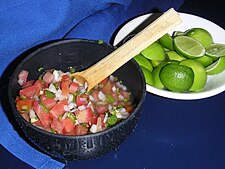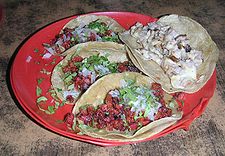This is an old revision of this page, as edited by Steel (talk | contribs) at 18:21, 5 June 2006 (Revert to revision 56640435 using popups). The present address (URL) is a permanent link to this revision, which may differ significantly from the current revision.
Revision as of 18:21, 5 June 2006 by Steel (talk | contribs) (Revert to revision 56640435 using popups)(diff) ← Previous revision | Latest revision (diff) | Newer revision → (diff)Mexican food is a style of food that originated in Mexico.
Mexican cuisine is known for its intense and varied flavors, colorful decoration, and the variety of spices that it has. Mexican gastronomy, in terms of diversity of appealing tastes and textures, is one of the richest in the world in proteins, vitamins, and minerals, though some people characterize it as greasy and excessively spicy.
When Spanish conquistadores arrived in the Aztec capital Tenochtitlan (on the ruins of which Mexico City was built), they found that the common people's diet consisted largely of corn-based dishes with chilis and herbs, usually complemented with beans and squash. Later on, the conquistadores added to their original diet of rice, beef, pork, chicken, wine, garlic, and onions that they brought with them from Spain to the indigenous foods of pre-Columbian Mexico (including chocolate, maize, tomato, vanilla, avocado, papaya, pineapple, chile pepper, beans, squash, sweet potato, peanut and turkey). The totopo (a deep-fried chip of corn tortilla) may have been created as part of this cuisine.
Most of today's Mexican cuisine is based on pre-hispanic traditions, including the Aztecs and Maya, combined with culinary trends introduced by Spanish colonists. Quesadillas, for example, are a flour or corn tortilla with cheese (often a Mexican-style soft farmer's cheese such as Queso Fresco), beef, chicken, pork, etc. The indigenous part of this and many other traditional foods is the chile pepper. Foods like these tend to be very colorful because of the rich variety of vegetables (among them red peppers, green peppers, chiles, broccoli, cauliflower, and radishes) and meats in Mexican food. There is also a sprinkling of Caribbean influence in Mexican cuisine, particularly in some regional dishes from the states of Veracruz and Yucatan. The French occupation of Mexico also yielded some influences as well: the bolillo, a Mexican take on the French roll, certainly seems to reflect this.
Mexican food varies by region, because of local climate and geography and ethnic differences among the indigenous inhabitants and because these different populations were influenced by the Spaniards in varying degrees. The north of Mexico is known for its beef production and meat dishes; southeastern Mexico, on the other hand, is known for its spicy vegetable and chicken-based dishes. Veracruz-style is a common method of preparing seafood.
There are also more exotic dishes, cooked in the Aztec or Maya style, with ingredients ranging from iguana to rattlesnake, deer, spider monkey, and even some kinds of insects. This is usually known as comida prehispanica (or prehispanic food), and although not very common, is relatively well known.
Mexican cuisine has combined with the cuisine of the southwest United States to form Tex-Mex cuisine.
One type of food that is commonly mistaken for Mexican food is New Mexican cuisine, which can be found in, of course, New Mexico, USA.
Traditional dishes




Foods that are part of the Mexican culinary tradition include:
- aguas frescas
- albóndigas
- arroz con pollo
- arroz Español (Spanish rice)
- ate
- atole or champurrado
- bacalao
- bacanora
- barbacoa
- birria
- bistec picado
- bolillos
- burritos
- cajeta
- calabaza
- camote
- capirotada
- carne asada
- carnitas
- cecina
- chapulines and escamoles
- charales, small fish, basically a type of smelt
- chicharrón and chicharrones
- chilaquiles
- chiles en nogada
- chiles rellenos
- chilorio
- chocolate
- chorizo
- churipo
- cochinita pibil
- cocido
- cóctel de camarón and other seafood cocktails
- caldo de queso
- caldo de pollo (chicken soup), other caldos are made from beef, seafood, etc.
- coyotas
- empanadas
- enchilada (red or green)
- enchilada suiza
- ensalada de fruta
- flautas
- frijoles pintos
- frijoles negros
- frijoles charros
- frijoles refritos (Refried beans)
- gorditas
- glorias
- gringas
- guacamole
- horchata
- huevos divorciados
- huevos motuleños
- huevos rancheros
- jamoncillos
- jicama
- lengua
- lentejas
- longaniza
- machaca
- mancha manteles
- mariscos
- menudo
- mezcal
- michelada
- milanesa
- mixiotes
- mole
- molletes
- moronga
- nopalitos
- pambazos
- papas (potatoes)
- parilladas
- picadillo
- pico de gallo
- platano
- pollo asado
- pollo picado
- pollo rostizado
- polvorones
- pozole
- pulpo(From the Sinaloa Fish Recepies)
- quesadillas
- rajas con crema
- romeritos
- salsa
- sopes
- sopa azteca
- sopa de pollo
- sopa tarasca
- tacos
- tamales
- tepache
- tequila
- tortillas
- tortas (sandwiches)
- "Tortas de...." Small omelettes similar to egg foo yung patties.
- tostadas
- tlacoyos
- tlayudas
- venado, particularly in the Yucatan.
- yuca